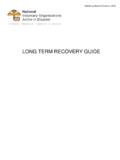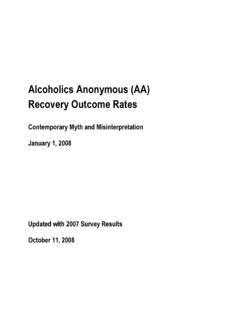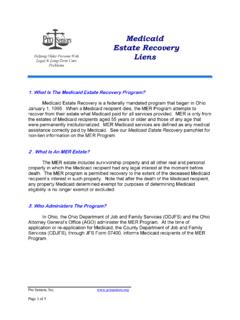Transcription of The Long-Term Care Industry
1 47 Chapter 3 The Long-Term care IndustryWhat You Will Learn The primary component of the Long-Term care Industry consists ofvarious providers in community-based settings, quasi-institutions,and institutional facilities. The Industry cannot function without otherkey partners. Home health care is a prime example of community-based long -termcare providers. Others include homemaker and personal care serviceproviders, adult day care providers, and hospice service providers. Independent living and retirement centers and custodial care providerssuch as adult foster care facilities can be referred to as quasi-institutions. Institutional providers are the most visible sector of the long -termcare Industry . They range from assisted living facilities to a varietyof providers that are commonly referred to as nursing homes. Someinstitutional Long-Term care services are based in hospitals.
2 Commercial insurance companies and managed care organizationsplay a critical role in the financing of Long-Term care services. A variety of health care personnel are involved in the delivery oflong-term care . They can be classified as administrative profession-als, clinicians, paraprofessional caregivers, ancillary personnel, andsocial support professionals. The ancillary sector includes case management agencies that assistclients with identifying and obtaining appropriate Long-Term careservices, Long-Term care pharmacies that provide drug managementand pharmaceuticals to facilities, and developers of Long-Term 8/4/09 9:44 AM Page 47 Jones and Bartlett Publishers, LLC. NOT FOR SALE OR DISTRIBUTIONS cope of the IndustryEfficient delivery of services to a nation spopulation necessitates a Long-Term care (LTC) Industry .
3 The Industry in the UnitedStates has been shaped primarily by LTCpolicy. But, the government s role has beenmainly indirect as a financier and regula-tor. The government plays a very small rolein the direct delivery of LTC services. TheLTC Industry mainly consists of providersof services other than informal caregiversand government agencies that deliver socialservices. Among the providers are hospital-based LTC services that emerged in the late1980s. Hospice services provide end-of-lifecare and are regarded as a component oflong-term care . The Industry cannot functionwithout other key partners. These partners in-clude the insurance Industry , managed careorganizations, professionals employed in theLTC Industry , case management agencies, Long-Term care pharmacies, and developersof Provider SectorProvidersare organizations or individualsthat deliver LTC services and get paid for theservices delivered.
4 The health care industryis replete with examples of providers, includ-ing hospitals, nursing homes, home healthagencies, hospices, physicians, pharmacists,and laboratories. Various private organiza-tions and facilities, both for-profit and non-profit, are part of the LTC Industry . Mostof these organizations deliver institutionalcare, but the private sector that deliverscommunity-based services has also prime example is home health care , whichhas been a growing Industry in itself. TheLTC Industry is predominantly funded by thegovernment, and certain sectors of the indus-try are more stringently regulated than Service ProvidersFour main types of providers constitute thecommunity-based sector of the LTC Industry :(1) certified home health providers, (2) home-maker and personal care service providers,(3) adult day care providers, and (4) hospiceservice Home Health ProvidersHome health care is consistent with the phi-losophy of maintaining people in the leastrestrictive environment possible.
5 Without theavailability of skilled nursing care and reha-bilitation services in patients own homes,the patients would have to be in hospitals ornursing homes to receive the same servicesat a much higher pointed out in Chapter 2, the 1988class-action lawsuit of Duggan v. Bowenwasinstrumental in expanding home health ben-efits under Medicare. The new rules that tookeffect in 1989 (1) removed the requirement ofa three-day hospital stay before home healthvisits would be covered under Medicare, (2)abolished the maximum limit of 100 visits,and (3) included coverage for skilled obser-vation with stable health needs rather than ex-pectations of improvement, as the formercriterion had specified. In spite of thesechanges, Medicare criteria continue to focuson recovery from acute illness, not long -termmaintenance or assistance with functional dis-ability (Hughes & Renehan, 2005).
6 Althoughvisits continue until the client s plan of care isaddressed, this period is short, often a few48 CHAPTER 3 The Long-Term care 8/4/09 9:44 AM Page 48 Jones and Bartlett Publishers, LLC. NOT FOR SALE OR DISTRIBUTION weeks in length for most clients (Dieckmann,2005).Between 1990 and 1996 alone, the num-ber of home health care providers grew from5,800 to 9,900 (Liu et al., 1999). In 2007,there were 9,284 Medicare-certified homehealth agencies. Of these, 17% were affili-ated with an institution such as a hospital ornursing facility and 83% were freestanding(NAHC, 2008). Medicare is the largest sin-gle payer for home health services. ForMedicaid beneficiaries, states pay for thesame services that Medicare does. Privateinsurance also includes skilled home addition to Medicare-certified agen-cies, there are numerous noncertified homecare agencies, home care aide organizations,and hospices.
7 Often, such agencies do notprovide the breadth of services that Medicarerequires. For example, home health aide or-ganizations do not provide skilled nursingcare (NAHC, 2008).Homemaker and Personal care Service ProvidersVarious private agencies offer services forin-home assistance. Some of these agenciesare also Medicare-certified to deliver skillednursing and rehabilitation care . Homemakerand personal care services, however, are notcovered under the Medicare program. Tovarying degrees, states pay for homemakerand personal care for Medicaid funds are used to pay for these ser-vices by those who do not qualify for Med-icaid. Homemaker and personal servicesinclude assistance with personal hygiene(such as bathing), light housework, laundry,meal preparation, transportation, and gro-cery Day care ProvidersAdult day care is a nonresidential, communi-ty-based extramural service.
8 It enables peo-ple to live with their families and fulfillsfamily caregivers need for respite so they cango to work during the day. These centers maybe located in senior centers, nursing facilities,churches or synagogues, or hospitals. Manycenters also provide transportation from hometo the center and back. On the other hand, lackof transportation and the high cost of trans-portation are also major impediments to theuse of adult day services (O Keeffe & Siebe-naler, 2006).Based on their focus, there are three mainmodels of adult day services (NADSA,2008): (1) the social model emphasizes recre-ation and furnishes meals and some basichealth-related services; (2) the medical/healthmodel provides nursing care and rehabilita-tion therapies in addition to social activities;and (3) the specialized model provides ser-vices only to specific care recipients, such asthose with dementia or developmental dis-abilities.
9 Many programs combine the firsttwo models. Among those using adult dayservices nationwide, 52% have some cogni-tive impairment and are the largest users ofthis type of service. Other users are frail el-derly who need supervision and those withmental retardation/developmental disabilities(PIC, 2003).In 2002, more than 3,400 adult day cen-ters were operating in the United States, andthey provided care to 150,000 adults each day(PIC, 2003). The vast majority were operatedby a parent organization, such as a hospital ornursing facility, on a nonprofit basis. Adultday care has become a growth Industry be-cause of rising demand, and an increasingnumber of for-profit centers are being Provider 8/4/09 9:44 AM Page 49 Jones and Bartlett Publishers, LLC. NOT FOR SALE OR DISTRIBUTIONThe national average for adult day carecost is around $56 per day (Feldstein, 2008).
10 Costs often vary by the type of service, par-ticularly the extent of health care services theparticipant requires. Medicare does not payfor adult day care , but expenses can be cov-ered through a variety of other sources. Un-der the home- and community-based services(HCBS) waiver program, introduced in Chap-ter 2, Medicaid is the leading source of pay-ment for adult day care . Other sources offunding include Title III of the Older Amer-icans Act, Veterans Health Administration,private Long-Term care insurance, and privateout-of-pocket funds. Some rehabilitation ther-apies may be covered under Service ProvidersHospice services were introduced in Chapter1. Medicare added hospice benefits in 1983,10 years after the first hospice opened in theUnited States. For a patient to receive hospicebenefits, a physician must certify that the pa-tient is terminally ill and that the patient s lifeexpectancy is six months or less.
















